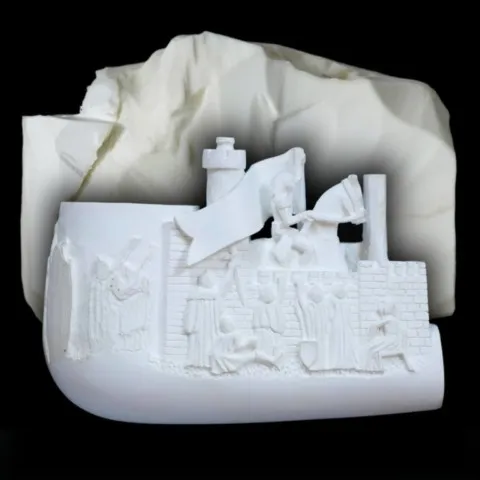SEPIOLITE
Class : Silicates
Subclass : Phyllosilicates
Crystal system : Orthorhombic
Chemistry : Mg4Si6O15(OH)2 6H2O
Rarity : Fairly common
Sepiolite is a magnesian clay, belonging to the palygorskite group. Its particular atomic structure is however intermediate between that of an inosilicate and a phyllosilicate. It is a mineral that forms in two different contexts : by alteration of serpentinites, then constituting fibrous masses of elongated crystals reaching up to 2 cm, or fibrous veinlets reminiscent of chrysotile; more commonly, sepiolite constitutes beds or nodules in sedimentary rocks, notably limestones. Its name comes from the Greek sêpion (cuttlefish bone) for its similarity of density, its porosity and its color. Indeed, sepiolite is white to grayish or yellowish in color, sepiolite nodules are very light (they float on water) and have a soft touch. Fibrous sepiolite is white. The crystals are never clear, although millimeter-sized individuals have been reported. Sepiolite is sometimes referred to as "sea foam", it was once used in the making of pipe bowls. The names "mountain leather", "mountain wool", and "mountain cardboard" refer to very light porous aggregates of palygorskite or sepiolite fibers. These felted aggregates have an appearance reminiscent of cardboard plates, tear like it and can reach large dimensions. In addition to its use in the manufacture of art objects and pipes, sepiolite is an insulating material used in electronics and ceramics, and also has absorbent properties that are used in pharmacy and chemistry. In Spain, it is even used as a lightweight construction material.
Main photo : Sepiolite from Poudrette Quarry, Mont St-Hilaire, Quebec, Canada © Douglas Merson
Sepiolite in the World
Twinning
No known twinning for this mineral species.
Fakes and treatments
No fakes listed for this mineral species.
Hardness : 2
Density : 2.2
Fracture : Fibrous
Streak : White
TP : Translucent to opaque
RI : 1.498 to 1.579
Birefringence : 0.029 to 0.057
Optical character : Biaxial -
Pleochroism : None
Fluorescence : None
Solubility : Hydrochloric acid
Magnetism : NoneRadioactivity : None


